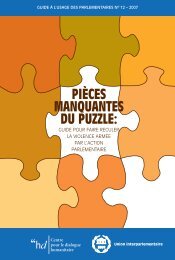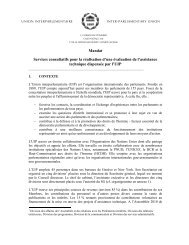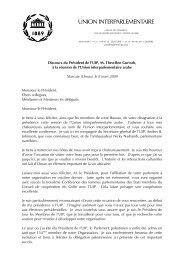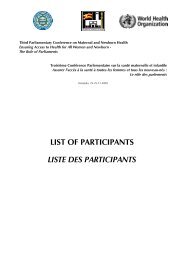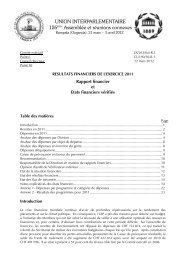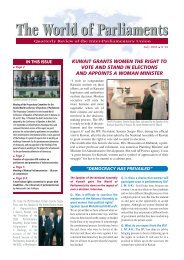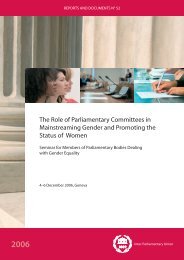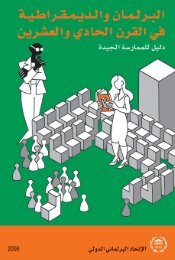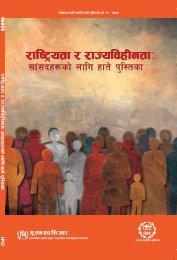MISSING PIECES - Inter-Parliamentary Union
MISSING PIECES - Inter-Parliamentary Union
MISSING PIECES - Inter-Parliamentary Union
You also want an ePaper? Increase the reach of your titles
YUMPU automatically turns print PDFs into web optimized ePapers that Google loves.
<strong>MISSING</strong> <strong>PIECES</strong><br />
ADAPTING POLICING TO LOCAL CONDITIONS<br />
In terms of violence prevention, it is important to update policing practices<br />
according to both good practices emerging from programme evaluations,<br />
and local conditions and particular risk factors. The World Report on Violence<br />
and Health calls for approaches that would also consider underlying<br />
societal, community and relationships factors, insisting that such prevention<br />
strategies will often be more cost-effective than policing and correctional<br />
responses. A number of criminal justice interventions are nevertheless<br />
reviewed, as ‘the policing models and types of intervention involved will<br />
strongly determine whether or not they are effective’. 28 Their principal<br />
recommendations are reproduced below in Box 18.<br />
BOX 18 CRIMINAL JUSTICE AND THE PREVENTION OF INTERPERSONAL<br />
VIOLENCE<br />
Policing will not reduce rates of victimisation by:<br />
• increasing budgets, even by large amounts. Instead, this will divert<br />
scarce financial resources away from public health and educational<br />
programmes that have been shown to significantly reduce crime and<br />
victimisation;<br />
• continuing the current policing models based upon patrols, response<br />
to calls for service, and investigation—all of which become less and less<br />
effective in reducing crime as fewer victims report incidents to the<br />
police; and<br />
• using popular programmes such as neighbourhood watch, boot camps,<br />
and drug resistance education, all of which have been shown to be<br />
ineffective in reducing crime and interpersonal violence.<br />
Policing will reduce rates of victimisation by:<br />
• deploying police officers strategically and holding them accountable to<br />
target specific problems;<br />
• adopting models for policing such as the Strategic Approaches to Community<br />
Safety, where joint police and university teams analyse the causes<br />
of violence, particularly for youth homicides;<br />
• providing data and collaborating in multi-sectoral partnerships (for<br />
example, with schools, welfare, and housing) that aim to tackle persistent<br />
offending by men who are high risk because of dropping out of<br />
school or having dysfunctional families;<br />
• targeting repeat victimisation—where the same person or address is<br />
victimised more than once—through a combination of enforcement,<br />
situational crime prevention, and social prevention;<br />
• empowering victims to protect themselves, for instance, by creating<br />
police stations where female victims of violence know they can talk to<br />
female police officers; and<br />
130



